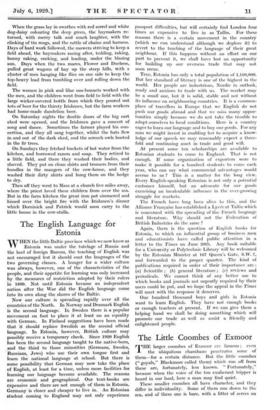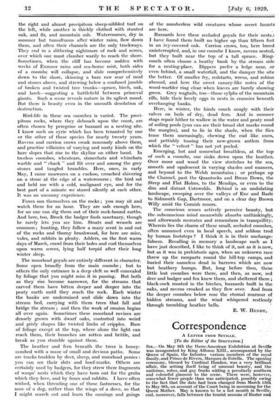The Little Coombes of Exmoor T HE larger coombes of Exmoor
are famous ; even the ubiquitous charabanc penetrates some of them—for a certain distance. But the little coombes (" goyals," Blackrnore called them) which run off from these are, fortunately, less known. "Fortunately," because when the voice of the too exuberant tripper is heard in our land, here a man may find quiet.
These smaller coombes all have character, and they differ in individuality. Some of them run down to the sea, and of these one is bare, with a litter of screes on the right and almost precipitous sheep-nibbled turf on the left, while another is thickly clothed with stunted oak, and fir, and mountain ash. Watercourses, dry in summer but tumultuous after winter rains, flow down them, and often their channels are the only trackways. They end in a slithering nightmare of rock and scree.s, over which one must clamber warily to reach the shore. Sometimes, when the cliff has become sodden with weeks of Exmoor rains and sea-borne mist, both sides of a coombe will collapse, and slide comprehensively down to the shore, skinning a bare raw scar of mud and stones above, and strewing below a confused jumble of broken and twisted tree trunks—spruce, birch, oak, and larch—suggesting a battlefield between primeval giants. Such a scene reveals nature in its ugliest mood. But there is beauty even in the uncouth desolation of destruction.
Bird-life in these sea coombes is varied. The preci- pitous rocks, where they debouch upon the coast, are often chosen by peregrine or buzzard as a nesting site. I know such an eyrie which has been tenanted by one or the other of these species for nearly twenty years. Ravens and carrion crows croak raucously above them, and practise villainies of varying and nasty kinds on the bare slopes that rise to the skyline on either hand. In treeless coombes, wheatears, stonechats and whinchats warble and " chack " and flit over and among the grey stones and tangled brambles. Here, once, in early May, I came unawares on a cuckoo, crouched shivering on a stone at the edge of a watercourse ; the bird sat and held me with a cold, malignant eye, and for the best part of a minute we stared silently at each other. It was an uncanny experience.
Foxes sun themselves on the rocks ; you may sit and watch them for an hour. They are safe enough here, for no one can dig them out of their rock-bound earths. And here, too, Brock the badger finds sanctuary, though he rarely lets you see him. Stoats and weasels are common ; hunting, they follow a mazy scent in and out of the rocks and thorny brushwood, for here are mice, voles, and rabbits in plenty. Adders, on the first warm days of March, crawl from their holes and curl themselves upon warm screes, lying half torpid after their long winter sleep.
The moorland goyals are entirely different in character.
Some open broadly from the main coombe ; but to others the only entrance is a deep cleft so well concealed by foliage that you might miss it in passing. But both as they rise become narrower, for the streams that carved them have bitten deeper and deeper into the peaty earth until they reach the rock. Each winter the banks are undermined and slide down into the stream bed, carrying with them trees that fall and bridge the stream ; and then the work of erosion begins all over again. Sometimes these moorland ravines are densely grown with dwarf oaks, contorted into weird and grisly shapes like twisted limbs of cripples. Bare of foliage except at the top, where alone the light can reach them, their branches are rotten and brittle, and break as you stumble against them.
The heather and fern beneath the trees is honey- combed with a maze of small and devious paths. Some are tracks trodden by deer, sheep, and moorland ponies : you can see their slots and hoof-marks. Others are certainly used by badgers, for they strew there fragments of wasps' nests which they have torn out for the grubs which they love, and by foxes and rabbits. I have often wished, when threading one of these fastnesses, for the nose of a dog, rather than the wings of a dove, so that I might search out and learn the comings and goings of the numberless wild creatures whose secret haunts are here.
Buzzards love these secluded goyals for their nests,: I have found them.' built no higher up than fifteen feet in an ivy-covered oak. Carrion crows, too, here breed .uninterrupted, and, in one coombe r know, ravens nested, but they built near the top a a tall spruce. Ring- ousels often choose a heathy bank by the stream side for nesting-place. ,Dippers prefer a ledge near, _or even behind, a small waterfall, and the damper the site the better. Of smaller fry, redstarts, wrens, and robins abound, and here the sweet canary-like notes of the wood-warbler ring clear- when leaves are barely showing green. Grey wagtails, too—those sylphs of the mountain _rills, hide their lovely eggs in nests jn crannies beneath overhanging banks.
Here, in winter, the hinds couch snugly with their calves on beds of dry, dead fern. And in summer stags repair hither to wallow in the water and peaty mud of soiling pools (you can see their broad slot marks round the margins), and to lie in the shade, when the flies tease them unceasingly, chewing the cud like oxen, and pettishly tossing their new-grown antlers from which the " velvet " has not yet peeled.
Emerging, hot and somewhat breathless, at the top of such a coombe, one sinks down upon the heather. Over moor and wood the view stretches to the sea, smooth and opalescent in varying shades and nuances, and beyond to the Welsh mountains ; or perhaps up the Channel, past the Quantocks and Brean Down, the Steep and Flat Holms, to the Mendips, or even to the dim and distant Cotswolds. Behind is an undulating landscape, sweeping over the valleys of Exe and Bark to Sidmouth Gap, Dartmoor, and on a clear day Brown Willy amid the Cornish moors.
The conscious senses actively perceive beauty, but the. subconscious mind meanwhile absorbs unthinkingly, and afterwards recreates and remembers in tranquillity. Wherein lies the charm of these small, secluded coombes, often unnamed even in local speech, and seldom trod by human footsteps ? I think it is in their. michange- fulness. Recalling in memory a landscape such as I have just described, I like to think of it, not as it is now, but as it was in prehistoric ages, when an unknown race threw up the ramparts round the hill-top camps, and buried their nameless dead in barrows which are now but heathery humps. But, long before then, these little lost coombes were there, and then, as now, red deer and badger and fox knew them, and sheltered there ; black-cock roosted in the birches, buzzards built in the oaks, and ravens croaked as they flew over. And from the deeper coombes below rose the eternal murmur of hidden streams, and the wind whispered restlessly through trembling heather bells.
E. W. HENDY.











































 Previous page
Previous page